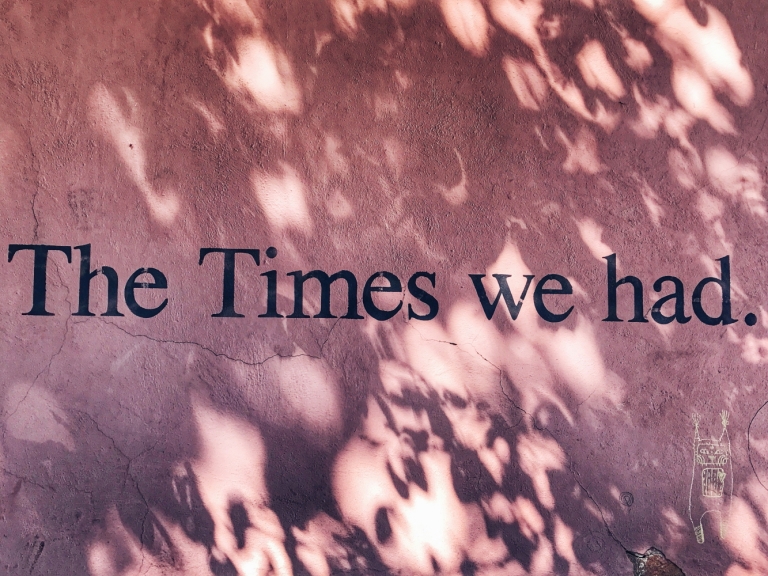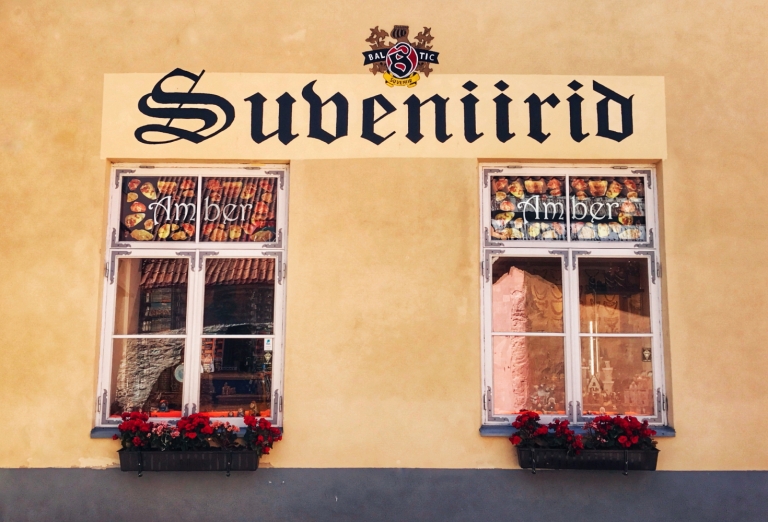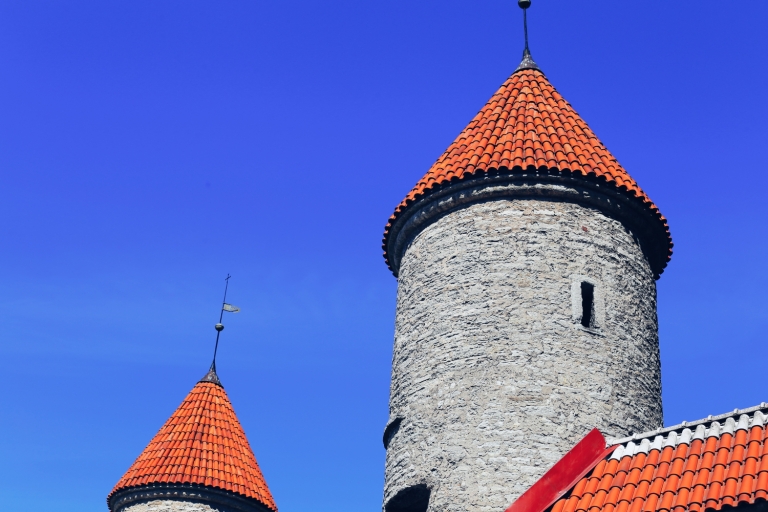RO: Na poftim, cel mai micut dintre cele trei state baltice si cea mai nevalurita in ceea ce priveste relieful (noroc cu un picut de dealuri mai la sud, ca-n rest e plina de campii si terenuri mai plate ca hartia) avea sa ne uimeasca inca de cand am trecut rapid prin “piripunkt“-ul de granita dintre Letonia si e-Stonia. Pai n-au dat ei estonienii Skype si Taxify pentru omenire? Si nu sunt ei renumiti in toata Europa ca fiind cea mai digitalizata tara, de la sistemul bancar, la votul electronic si la conexiunile perfecte la internet?! Bun, dar acum ca tot a ajuns romanasul carcotas pe pamant baltic, am cam zdruncinat din temelie sistemul bancar cand am binevoit sa platim cu un card contactless la supermarket sau cu unul de oricare tip o fi la intrarea in manastirea Pirita din Tallinn. Si no offense popoare baltice, nimeni, nimic si niciunde nu bate internetul din Romania 🙂
EN: There you go, the smallest country from the Baltics and the less wavy from all three of them in terms of relief (thanks God for the southern hills, as the rest of the country is full of lowland and plain as paper terrains) will conquer our hearts from the very beginning, since we rapidly passed the “piripunkt”, the border between Latvia and e-Stonia. Well didn’t the Estonians give Skype and Taxify for the humanity? And aren’t they renowned in the entire Europe as the most digital country, starting from the banking system to electronic vote and perfect internet connections?! Oh well, now that the grumbling Romanians have arrived on Baltic lands, we actually cut the banking system to pieces when we tried to pay with a contactless card at the supermarket or with any kind of card when trying to visit Pirita convent in Tallinn. And no offense Baltic people, no one, nothing and nowhere beats the Romanian internet 🙂




RO: Daaaaar, Estonia are ea asii sai din maneca, cu care reuseste sa se diferentieze de vecinele sale baltice. O fi poate cea mai expusa catre Mother Russia, insa cele mai pregnante influente sunt cele scandinave, nicidecum rusesti. Pana si limba se aseamana oarecum cu finlandeza. Si chiar daca mai sunt inca multi vorbitori de rusa prin zona (ca doar de, fosta tara sovietica), mai degraba auzi finlandeza pe strazi. Nu degeaba sunt o groaza de croaziere si curse de feriboturi pe zi intre Helsinki si Tallinn, aducand buluc turisti finlandezi sa viziteze capitala estoniana. Si apropo, de nu sunt suficiente influentele finlandeze ca sa demonstreze ca Estonia pare mai mult o tara scandinava decat una fost sovietica, pana si numele capitalei a fost dat de catre cuceritorii danezi, care au navalit in zona pe la 1200. Asa ca Tallinn (aka Taani Linn) s-ar traduce de fapt si de drept… Orasul Danez 🙂 Si ca sa fie tacamul complet, si suedezii au avut ce-au avut cu Estonia, asa ca prin secolul 16 tarisoara din nordul balticelor le-a cam apartinut. Asta pana cand au aparut rusii in peisaj, bineinteles, si-au cam zdruncinat din temelii intregul regim politic. Si-o fi avut biata tara o perioada scurta de independenta, insa in final tot in mainile sovieticilor a ajuns, urmand ca abia in 1991 sa isi dobandeasca cu adevarat independenta. Hurray!
EN: Buuuut, Estonia has its aces up the sleeve and manages to stand out compared to the other Baltic neighbors. It might be the most exposed to Mother Russia, but the most significant influences are the Scandinavian ones, not the Russian ones. Even the language itself somehow resembles with Finnish. And even though there are still quite a lot of Russian speakers in the area (well what can we do, ex Soviet country), one can hear more often Finnish being spoken. And there are actually quite a lot of cruises and ferries each day between Helsinki and Tallinn, bringing lots of Finnish tourists to visit the Estonian capital. And by the way, if there are enough Finnish influences to prove that Estonia is more Scandinavian than ex-Soviet, even the name of the capital was given by the Danish conquerors, who invaded the area around 1200. So Tallinn (aka Taani Linn) would actually translate as… The Danish City 🙂 And funny thing, the Swedish also had a thing for Estonia, so in the 16th century this small country actually belonged to them. That happened until the Russians came in, of course, and that shook the political regime from that time. And maybe the poor country has some time of independence but in the end they also got in the hands of Soviet people but in 1991 they finally obtained their independence. Hurray!

RO: Cert e ca Tallinn e o bijuterie. O fi el mult mai mic si mult mai aglomerat ca Riga, vecina mai faimoasa care se mandreste cu titlul de capitala a Balticelor, si poate ca nu o avea farmecul cladirilor art nouveau de pe ielele Brivibas si Alberta, insa are un centru vechi de toata frumusetea. Pe care-l vezi de sus, de pe dealul Toompea, cand te inghesui printre cardurile de turisti sa faci o poza cu acoperisurile rosii si turnurile cetatii vazute in departare, de pe platformele Kohtuosa si/sau Patkuli. Si ti-e mai mare dragul sa descoperi tot centrul vechi (care apropo, e patrimoniu Unesco inca de la 1991), cu strazile mici si inguste, bisericile ortodoxe (cica din varful bisericii Olaf s-ar vedea o priveliste dementiala a orasului), catedrala Alexander Nevsky cu arhitectura ei impunatoare care ne aminteste de Piata Rosie din Moscova, toate restaurantele locale, terasele aglomerate si pline de viata, mirosul de ciocolata traditionala Kalev (pai ce credeam, ca numai Letonia se mandreste cu Laima ei?!) si cel de lichior Vana Tallinn, bautura locala cea mai cautata de turistii veniti la asa numitele stag parties (petreceri de burlaci). Bautura nationala de fapt si de drept 🙂 Desi noi am cam prefera berea traditionala Saku 😀
EN: One thing is for sure. Tallinn is indeed a hidden gem. It might be much smaller and much more crowded than Riga, the famous neighbor that is proudly wearing the title of The Capital of the Baltics, and maybe it does not have the charm of the art nouveau buildings from Brivibas and Anlberta iela, but it has an old city center to die for! Which you can see from up above, from the Toompea Hill, when you’re cramming through the herds of tourists to take a picture with the red rooftops and the citadel towers seen at a distance, from the Kohtuosa or Patkuli platforms. And it’s a real pleasure to discover the old town center (which by the way, is part of the Unesco heritage since 1991), with its small and narrow streets, the Orthodox churches (people say that from up above the Olaf church there can be seen an amazing view with the city), the Alexander Nevsky cathedral, with its imposing architecture that reminds us of the Red Square in Moscow, all the local restaurants, the crowded and full of life terraces, the smell of Vana Tallinn liquor, the the most famous local drink among the tourists that come here for the so called stag parties. That’s the national drink to be more precise 🙂 Even though we still prefer the traditional beer Saku 🙂

















RO: Centrul Vechi al Tallinn-ului este cel mai bine conservat oras medieval din toata Europa de Nord. Pai daca in timpul razboaielor n-a fost chiar un punct de interes, fara prea multa activitate si fara prea mult comert, a scapat ca prin urechile acului de tot ce inseamna bombardamente si demolari, asa ca nu-i de mirare ca mai are inca atat de multe turnuri originale, absolut intacte. Pana la urma, turnurile de piatra sunt simbolul orasului 🙂 Piata Primariei (Raekoja Plats) e centrul distractiei talineze 🙂 Cea mai mare si mai impunatoare piata din tot centrul vechi, cu cladiri colorate ce amintesc de satucele bavareze. Pai cum sa nu isi puna nemtii amprenta si in arhitectura locala, daca pret de cateva secole ei au facut legea in zona balticelor? 🙂 Ce-i drept, cand ajungi in piata centrala de zilele orasului, sansele sa vezi ceva in jur sunt cam mici. Dar nu incepem iar cu polologhia despre aglomeratia din Tallinn 😀
EN: Tallinn old town is the best preserved medieval town in the entire Northern Europe. Well that’s quite expected as during the world wars this wasn’t quite an interesting point, with not that much activity or commerce, so it had a narrow escape from all the bombardments and demolitions so there’s no wonder that they still have most of the original towers, completely intact. In the end, the stone towers are the symbol of the city 🙂 The City Hall (Raekoja Plats) is the center of the Tallinn’s fun. The biggest and the most imposing market in the entire old city center, with colorful buildings that remind us of the Bavarian villages. How could the Germans not influence the local architecture, if they ruled the area for a couple of centuries? 🙂 But to be honest, when you get to the central market during the Old Town Days, chances are that you can’t see anything around. But we’ll not gonna start it over and over again with the crams from Tallinn 😀
















RO: Cat despre mancare… tarile baltice au ce au cu mancarurile grele, cu carnurile, carnatii si sosurile in abundenta – cum altfel sa supravietuiesti unor ierni atat de friguroase, daca nu cu mancaruri abundente in calorii?Rade ciob de oala sparta pan’ la urma, de parca romanii ar manca numai mancaruri fusion (fusion-confusion mai degraba, cum am gasit in descrierea unui restaurant din Tallinn). Cert e ca in Estonia si Letonia se simte influenta nemtilor si-a rusilor in gastronomie, in timp ce Lituania ramane inca fidela mancarurilor poloneze. Asa ca orice restaurant traditional estonian serveste bere delicioasa, paine de secara (ca tot am devenit mari fani dupa cea incercata in Islanda), carnuri in fel si chip (predominant porc), cartofi ca garnitura (logiiiiic!) si mult usturoi. Suna familiar, asa-i? 🙂 Cu alte cuvinte, orice masa traditionala estoniana e un festin! Noroc cu marea Baltica la o aruncatura de bat, ca s-a mai rafinat meniul balticilor cu ceva somon, pastrav sau hering 🙂 Si cum nici Estonia nu s-a putut da in laturi curentului hipsteresc, in ultima perioada au aparut o multime de locuri “fancy-trancy”, cu mancaruri sanatoase, avocado-uri si vegetarianisme. Asa ca bagam capul in pamant si recunoastem cu rusine ca numai pe acestea le-am incercat. Mai exact barul cel mai cautat si frecventat de localnici, un pic inafara centrului vechi, Must Puudel, cu o atmosfera ex-sovietica, carpete pe pereti, covoare ca acasa la bunici si reviste vechi de cand lumea si pamantul!
EN: As for the food… the Baltic countries have a thing for the heavy food, meat, sausages and abounding sauces. How else can you survive to such harsh winters if not with hyper caloric meals? But what do you know, the pot calls the kettle black, as the Romanian would only eat fusion food (fusion-confusion more precisely, as we have found in the description of a restaurant in Tallinn). But one thing is for sure. In Estonia and Latvia you can still feel the influences from the Russians and Germans in gastronomy, while Lithuania is still a big fan of the Polish food. So each and every single traditional Estonian restaurant will serve delicious beer, rye bread (as we now love it after we’ve tried it in Iceland), all kind of meats (mostly pork), potatoes as side dish (oof coooourse!) and tons of garlic. Sounds familiar, isn’t it? 🙂 In other words, any traditional Estonian meal is a feast! But luckily, the Baltic Sea is just across the corner and the Baltic menu has been refined quite a bit with some salmon, trout or herring 🙂 And of course that Estonia couldn’t resist the hipsterish trend, so in the last period of time there are quite a few fancy locals with great food, avocados and all kind of vegetarian stuff. So we have to admit that these are the only ones that we’ve tried. More precisely the most famous bars recommended by the locals, a bit outside the city center, Must Puudel, with an ex-Soviet charm, carpets on the walls, rugs as you find in our grandparents homes and old magazines!






RO: Si-apoi kohvik-ul (restaurantul, ca de cand am invatat un amarat de cuvant ne dam mari vorbitori de estoniana) Komeet, de la ultimul etaj al centrului comercial Solaris. Nu de alta, dar privelistea deasupra orasului e tare frumoasa, mancarea buna iar prajiturile… nici n-au nevoie de descriere. Si fix in fata e cladirea Operei si marea de verdeata care defineste orasul. Parca am mai spus ca 40% din suprafata tarilor baltice este acoperita de paduri, asa-i? 🙂
EN: And then the Komeet kohvik (aka the restaurant – we barely got one word in Estonian and we’re now the experts), from the last storey of the Solaris commercial center. The views are fantastic, the food is good and the cakes… they need no kind of presentation. And just in front of us is the Opera building and the huge greenery that defines the city. Did we already say that 40% from the Baltics surface is covered by forests? 🙂

RO: Sau barul Frank, in apropiere de faimoasa (si mult prea aglomerata) strada Viru, renumita pentru restaurantele (scumpe si prea turistice am spune noi), magazinele de suveniruri, cele doua turnuri de piatra si piata de flori. Si daca tot am ajuns la suveniruri, exista cateva reguli de baza care ar cam trebui respectate inainte de a ne pierde mintile printre magneti de frigider si alte produse mai mult sau mai putin traditionale. Matrioscele sunt rusesti, de la cea mai mica la cea mai mare, indiferent de ce ar spune comerciantii. Da, e adevarat, tarile baltice sunt tari ex-sovietice, dar asta nu inseamna ca produsele traditionale rusesti au devenit si baltice intre timp. Si-apoi chihlimbarul si toate magazinele care vand bijuterii si produse din chihlimbar. Fara nicio suparare, dar Estonia nu-i mare producatoare de chihlimbar. In schimb vecinele baltice Letonia si Lituania sunt, chiar daca nu la nivelul enclavei ruse Kaliningrad, unde pare-se ca ar fi Raiul pe pamant al chihlimbarului 🙂 Dar tare ne-am umple bagajele cu ciocolata traditionala Kalev (ca doar am dat iama in magazinele Laima din Riga, de ce nu ne-am imbuiba si cu ciocolata estoniana? :D) si tare am mai tanji dupa o lanosenie traditionala si calduroasa, pentru ca in ciuda pozelor noastre insorite, vremea-i tare dubioasa (si friguroasa) in Baltice – chiar si la inceput de vara 🙂
EN: Or Frank Bar, close to the famous (and way to crowded) Viru street, renowned for its restaurants (expensive and way too touristy in our judgement), the souvenir stores, those two stone towers and the flower market. Ad now that we’ve got to souvenirs, there are some base rules that should be followed before loosing our minds through fridge magnets and other more or less traditional products. The matrioska dolls are RUssians, from the smallest to the largest, no matter what the sellers would say. Yes, it is true that the Baltics are ex-Soviet countries but that doesn’t mean that the traditional Russian objects have become Baltic as well in the meantime. And then the amber and all those stores that sell jewelry and amber products. No offense, but Estonia is not such a big amber producer. On the other hand, the Baltic neighbors Latvia and Lithuania are, even though not at the same level as the Russian enclave Kaliningrad, where there seems to be Heaven on Earth in terms of amber. But we would really want to fill our luggage with traditional Kalev chocolate (we did that with Laima chocolate in Riga so why not indulge ourselves with some Estonian one? :D) and we would really need some traditional and extremely warm wool, because despite the sunny pictures, the weather here is quite strange (and very cold) – even though is summer 🙂





RO: Dar iar ne-am intins la vorba si povestit si iar am umplut ditamai articolul de ne dor degetele dand scroll printre atata text si poze. Mai lasam si pentru partea a doua, ca mai avem multe de spus si despre locurile mai putin cunoscute, dinafara centrului vechi al Tallinn-ului. Pentru ca slava cerului, sunt destule! Revenim! 🙂
EN: But once again we kept talking on and on and filled this article so much that our fingers ache when scrolling through all that text and photos 🙂 We’re leaving something for the second part, as we still have plenty of things to tell about the less known place, outside the city center of Tallinn. Because, thanks God, there are plenty of them! We’ll be back!
